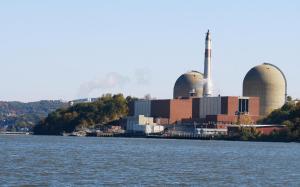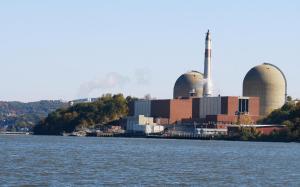
By Roger Witherspoon
The large black sailor was naked in the middle of a roped-off area below decks, and he was none too happy.
“He kept saying ‘Not my boots, too. My wife just bought them for me.’ But they made him take them off anyway, and he was just there, naked. Then they made him scrub,” recalled Maurice Enis, navigator of the USS Ronald Reagan, one of the Navy’s newest aircraft carriers.
“They gave him this really abrasive stuff that we use to clean the hull of the ship. It’s sort of like liquid sandpaper. And he had to scrub all over while everyone watched. Then he walked over to the sink and rinsed it off, then came back and stood while they ran the Geiger counter over him. He had to keep doing it till the Geiger counter was quiet.
“Then it was my turn.”
There was a dark turn to Operation Tomodachi, the massive search and rescue effort launched March 11, 2011, off the northern coast of Japan which had been ravaged by an earthquake and giant tsunami. The combined natural disasters left some 20,000 Japanese dead and the coastal infrastructure destroyed. Tomodachi, the Japanese word for “friend”, was an 80-day mission requested by the Japanese government and coordinated by the US State Department and the Department of Defense. The DoD quickly mobilized its 63 Japanese bases and called in the USS Ronald Reagan, carrying 5,500 sailors and Marines, along with its Strike Group consisting of four destroyers – The Preble, McCampbell, Curtis Wilbur, and McCain – the Cruiser USS Chancellorsville, and several support ships ( http://bit.ly/11bfTqS ).

But the rescue mission quickly detoured down a dangerous, uncharted path. The earthquake had cracked Unit 1 of the Fukushima Daiichi nuclear reactors, and the tsunami had knocked out all power to the safety systems controlling Units 1 through 4. Control of the mission was expanded to include the Nuclear Regulatory Commission and the Department of Energy.
The fuel in Units 1 through 3 was quickly melting down. The fuel in Unit 4 had been offloaded to the spent fuel pool – which was located above the reactor itself – due to a planned refueling. By March 15 explosions had blown the roofs off and the walls out of all four reactor buildings and radiation was spewing into the air.
There was no power to circulate water in any of these buildings, so the Japanese had to improvise. They borrowed high powered pumping trucks from the Americans and poured water onto the buildings, let it run through the spent fuel pool and reactors, and out the bottom, where it flowed into the ocean. All the while, however, the Tokyo Electric Power Company and the Japanese government sought to minimize the radiological disaster. TEPCO would declare there was little or no radiation when, in fact, contamination was high and out of control.
There were some 70,000 American service members and their families in Japan and Defense officials were worried that they might all have to be evacuated. Family members were evacuated from Yokosuka Naval Air Base, 188 miles south of Fukushima, when radiation was detected in increasing amounts there. It was that detection which convinced American officials that the Japanese were not being honest. By calculating the amount of radiation that must have been released in order for Yokosuka to be threatened, NRC officials correctly deduced that despite Japanese assurances, the reactors had been breached.
But the overriding concern was for the Americans in the land based installations – the men and women of Operation Tomodachi were overlooked. And at times, they were just two miles off the coast of Fukushima as helicopters went back and forth, seeking survivors and transporting food and supplies.
The Americans at sea were on their own.
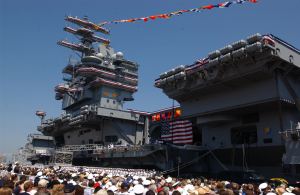
A Growing Fear
For Quartermaster Enis, the wait for decontamination was a completely unexpected turn of events. The quartermasters had two main responsibilities: navigating the ship, and operating the signal flags attached to the mast, which let others in the fleet know what the flagship was doing. Enis had been ordered to bring down the American flag, which had been flying atop the mast for two weeks, and bring it to the Captain’s quarters.
“I brought it down,” he said, “and folded it respectfully and tucked it under my right arm, next to my body. I carried it inside, put it away, and thought nothing of it.”
After dinner, he was walking past a sensor “and the alarms all went off,” he recalled. “And they began yelling at me not to touch anything or anyone and to go straight to the decontamination area.”
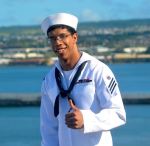
There was a line in the cordoned-off “decon” area with men and women waiting to be checked. But Enis didn’t have to wait – he was already marked and was ushered to the front, where a tableau was playing out under the watchful eyes of the Reagan’s executive officer and senior medical officer. The naked sailor in the center of the room was given a towel to cover himself and left. They called Enis.
“They had told us that there was no radiation,” said Enis. “When they started putting up the stations along the ship to check for radiation they didn’t say why they were there. They checked my boots and nothing happened. Then they checked my hands and the machine goes crazy.
“The guy doing the checking freaked out and said to ‘Step away from him!’ Next thing I know, I got plastic bags on my arms and they are telling everyone to get away from me. I almost had an anxiety attack because they were treating me like I had the plague. They weren’t touching me. They were yelling commands to where I had to walk and what I had to do. I had to scrub my hands and my right side with this gritty paint remover and it took off a couple of layers of skin.”
Enis was not told, then or later, exactly what his radiation reading was. They did say his was the highest level recorded among personnel on the ship. At that time, however, the radiation level was not his main concern. Fear of the unknown consumed his attention.
The officers were watching him and barking orders. His fellow sailors – men and women – silently watched him from the edges of the decon station while waiting their turn to be checked for radiation.
“It was pretty embarrassing,” said Enis. “You’re half naked and getting yelled at and scrubbing in front of all sorts of people and I’m scared because they are not telling me what is going on. The way they acted, I thought I must be in real trouble. And it scared the crew. None of us were experts on radiation. You ask yourself are you going to die? Are you going to get cancer? Are you going to be shipped off? I didn’t know if my skin was going to bubble up or something. I didn’t know anything.”

The Navy had been assured that radioactive particles could be washed away with soap and water. That was partly true. Particles emitting alpha rays, the weakest sort, could be washed away from smooth surfaces. Those emitting beta rays, which are stronger, can also be washed away as long as there are no breaks in the skin providing pathways to enter the body. The abrasive paint-removing soap used by the Navy, however, removed the top layers of skin. In addition, the carrier’s flight deck is not made of smooth plastic or glass. Merely scrubbing would not remove particulates from such porous surfaces.
The Reagan’s crew had been assured that there was no radiation to worry about over the open ocean and, as the ship’s navigator, Enis had been led to believe that the radiation was a distinct plume that they could avoid. It was now apparent that the radiation cloud was everywhere, and avoiding it would not always be possible.
On the quarter mile long deck there was another alarming note.
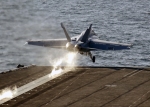
“I had a digital watch,” said quartermaster Jaime Plym, “and it suddenly stopped working. Somebody made a crack that radiation would do that. There were five or six of us on deck and everyone looked at their watches – and all the digital watches had stopped. There was one that was real expensive, and it wasn’t working either.
“We were laughing at first. But then that petered out and we just sort of looked at each other because it wasn’t funny anymore.”
And those who worked below decks had even less information to go on. The jet mechanics, said Jennifer Micke, had most of the aircraft parts brought down to them for testing. There was limited access to the huge hangar elevators.
“They set up a hatch watch,” Micke recalled, “which was people from the air squadrons sitting in folding chairs and making sure no one went on deck through the catwalk. They were to enter and exit only through the front of the ship because they wanted to reduce the level of contamination in the rest of the ship.

Jennifer Micke
“So they would pretty much sit there all day and yell at people who went the wrong way.”
Micke knew the jets on the flight deck were in a radioactive environment. “Every time we came off the flight deck,” she said, “some guy would have to scrub your boots and toss them in a pile and take them away. When you were going up on deck you would put on a pair of boots over your regular boots so they would have to throw those away. Then we had the chemical, biological, radiological suits that we had to put on.
“We were issued masks and canisters, but we never ended up actually using them.”
How well these precautions worked is an open question. An aircraft carrier is a complex industrial town and, at any given time, major and minor pieces of equipment are broken. Some of the damage came from normal wear and tear, and other damage came from accidents.
During Operation Tomodachi, the effectiveness of putting rags under the doors to limit the spread of air-borne radiation was compromised by the fact that there were broken doors, broken door jams and seals and, in some places, water-tight doors which had been removed and taken to the Reagan’s machine shop for repairs. On paper the USS Ronald Reagan was a series of closed compartments. In reality, it was more of a floating catacomb with the air flowing freely through it.
Nothing to Worry About
The official position of the US Navy is that there was very little radioactive contamination of any of its personnel. The Defense Department created the Tomodachi Medical Registry ( http://bit.ly/14ABPuj ) over a two year period, compiling the medical records of some 70,000 military personnel and their families who could have been exposed to varying amounts of radiation during the crisis in Japan.
The Registry was completed in December, 2012. One month later, the Department concluded that their estimates of the maximum possible whole body and thyroid doses of contaminants were not severe enough to warrant further examination. The Registry, the only epidemiologically valid way to determine over time if there is a pattern of illnesses which could be traced to that exposure, was abandoned.
Overlooked, however, is the fact that the Navy’s Registry, as a tool to accurately chronicle medical anomalies among the 70,000 contaminated Americans, was flawed in its inception. The Navy did not conduct a thorough medical examination of each person to establish an accurate baseline of their health. Instead, the Registry is an amalgam of all their latest health records.
In practice, that meant there was no real way to know what the actual baseline health condition was for each individual. Without that baseline, Veterans Administration physicians could not tell if the development of a tumor, or asthma, or cyst inside the body or on the skin represented a radical departure from the patient’s condition at the time of exposure to radiation or if the condition predated Operation Tomodachi. Without that baseline or an active registry showing similar medical issues among many service men and women, there is little chance for veterans to successfully claim that exposure to radiation lay at the root of their health problems.
The decision that the Americans in Japan were probably safe was not unreasonable. Ed Lyman, a nuclear physicist with the Union of Concerned Scientists, who is

Ed Lyman – Nuclear Physicist
writing a book on the meltdowns with nuclear safety engineer Dave Lochbaum and Pulitzer Prize-winning journalist Susan Stranahan, said that both government and independent researchers have tried to calculate the level of contaminants from the reactors at Fukushima Daiichi.
“The consensus was it wasn’t as bad as it could have been,” said Lyman. “It would be hard to see that anyone could have acquired a serious dose in that short a period of time. The dose rates were only high enough, from what’s publicly known, to cause that kind of injury fairly close to the plant grounds to have lasting health effects.
“Still, I am always in favor of collecting data. Five years may not be enough time for radiation –induced cancer to appear in most cases. But more data is always better.”
Others are more skeptical.
 “I had no faith in the Registry to begin with,” said Arnie Gundersen, a nuclear engineer and specialist in the spread of radiation in the environment. “With the atomic bomb survivors from the military program in the Utah desert, the registry that the Defense Department put together was bogus. The exposure they got was much greater than the Defense Department calculated.
“I had no faith in the Registry to begin with,” said Arnie Gundersen, a nuclear engineer and specialist in the spread of radiation in the environment. “With the atomic bomb survivors from the military program in the Utah desert, the registry that the Defense Department put together was bogus. The exposure they got was much greater than the Defense Department calculated.
“Knowing that the Defense Department has a history of putting people into harm’s way and then minimizing the exposure, I had no faith in this latest effort.”
Gundersen said he is “disappointed, but not surprised” that the Tomodachi Registry has been shelved. “It’s pretty clear that those on the Ronald Reagan got higher exposures than their commanding officers are claiming. Too many people had common symptoms that I can’t attribute to mass hysteria.
“One of the big uncalculated numbers are from the noble gasses. These blew over the carrier and they didn’t stick, but they are inhaled by personnel when you see the guys swabbing the decks to clear out particulates. That was a bad sign. You are not supposed to get particulates 100 miles offshore. So what the hell did the sailors breathe in? Their lungs have to have the same crap that was on the deck and in the water, and none of the Defense Departments exposure assessments take into account the hot particles in the sailors’ lungs.” ( https://www.youtube.com/watch?v=HCzuPm4T4qo )
And those who participated in Operation Tomodachi know that there are problems.
Collateral Damage
“My health started going south at the beginning of last year,” said Micke, the F-18 structural mechanic and hazmat coordinator on the USS Reagan. “On March 30, I was standing in formation during the change of command in California, and I passed out for the first time.

Jennifer Micke
“They told me I was just dehydrated, so I sat there in the medic area and drank a bottle of water. Then, on April 29, I passed out once more and this time they took me to the emergency room and I told them I had a headache.
“They said ‘Maybe you hit your head’. So they did a cat scan and came back and said ‘We found this mass in your brain’. I’ve had two surgeries since then and I’m out of the Navy.”
Technically, what the doctors found was a level 2, Oligoastrocytoma cancer ( http://en.wikipedia.org/wiki/Oligoastrocytoma ) in Micke’s frontal lobe. It is a pernicious, incurable cancer which lodges in the area of the brain responsible for coherent speech. Removing the bulk of the growth leaves a cavity which, in some cases, can collapse and cause collateral damage.
After Micke’s second surgery last fall she was informed that “it’s not active right now. The parts they left up there are just sitting there, dormant. I know they are up there, and it’s not as bad as it could be since they aren’t doing anything and it doesn’t hurt.
“I go back to the hospital every two months to have it checked. It’s pretty stressful, but it’s definitely livable.”
Living means she is back where it all began, on her parents’ farm in Thorp, Wisconsin, waiting for the next eruption of her cancer. “At this point,” said Micke, “I have so many doctors’ appointments that it is difficult to really do anything as far as getting a job 5 days a week. I don’t have a car so my parents are driving me everywhere.”
Micke has reconciled herself to living with the unpredictable. “My future plans haven’t changed severely,” she said. “I still plan on going to college, getting a good job, and continuing life. As for the cancer, it’s a part of me, like living with your hand. You come to terms with it and live with it.
“You live for today and be yourself and enjoy life for as long as you can.”
She is part of the group suing TEPCO for misleading the American government about the conditions of its reactors and the true release of radiation, which she blames for her condition.
“I’m just mainly doing it so it doesn’t happen to anybody else, just so somebody is held accountable,” she explained. “Hiding stuff messes with people’s lives in the long run, and I don’t want to see this happen to anybody else.
“As for the Navy, I don’t see where they could have done much more. It’s not something you train for. They did the best they could with the information they had. And I have great memories of the people I worked with, and the places I’ve been.”
To some degree, Micke is fortunate that she passed out and was diagnosed while still in the Navy. At the moment, her medical expenses are being covered. But that may change.
“The doctors have not determined yet if it is service connected,” Micke said.
Since the Defense Department has pre-determined that radiation did not cause any illnesses among its personnel and has cancelled the Tomodachi Medical Registry – which is the only epidemiological way to determine patterns of health problems – Micke may yet become a Navy veteran with an incurable cancer and no health care.
Ageing Fast
 Michael Sebourn had seen a lot of parts wear out during 17 years as a naval aircraft mechanic. Many of the helicopters he serviced at Atsugi saw heavy use and parts were replaced to ensure safety and maximum performance. But during Operation Tomodachi helicopter parts – particularly the radiators and air ducts – were replaced after just about every flight because of the huge amounts of radioactive particles they sucked into the engine.
Michael Sebourn had seen a lot of parts wear out during 17 years as a naval aircraft mechanic. Many of the helicopters he serviced at Atsugi saw heavy use and parts were replaced to ensure safety and maximum performance. But during Operation Tomodachi helicopter parts – particularly the radiators and air ducts – were replaced after just about every flight because of the huge amounts of radioactive particles they sucked into the engine.
“You couldn’t put the radiator back in,” said Sebourn. “It had to be replaced. We dumped it into a barrel full of water and soap and set the barrel behind a barrier, like a police line. Then every day we would take measurements to see if any of the radiation was seeping through.
“The barrels gave off radiation, and it takes years and years for the radioactive material to decay on its own. We would take off our Tyvek suits and cut them off and put them into the barrels, too. Everything that had seals or were dirty had to go into the barrels, since that’s what the radiation sticks to. The more we put into the barrels, the more the radiation grew. It seemed to feed on itself.”
That was a hectic 80-day period in the spring of 2011 which Sebourn thought was behind him forever. He was wrong. His eight-year-old son, Kai, got mysteriously ill in May, 2011.
“He went through vomiting fits and missed three weeks of school,” said Sebourn. “They had a rule then that if you threw up you were sent home, and he would throw up 10 – 15 times a day. He didn’t feel bad, but he couldn’t stop vomiting.
“Eventually they just wrote it off as stress. He still has those episodes and they never have been able to evaluate why he does it.”
But Sebourn was fine, until last year.
“In March of 2012 I got some medical problems which the Navy doctors couldn’t explain,” he said. “The right side of my body is at 40% to 50% of its normal strength. I’ve had two MRIs, had X-rays, ultrasound, and they can’t figure out what is wrong with me.
“My arm, chest and shoulder are sore and I’m getting disproportionately big on my left side, which is odd since I’m right handed and use that side more.”
Neither he nor Kai received genetic counseling or monitoring. After 17 years of service the Navy covers only Sebourn’s health care for five years, “and after that I’m on my own. Once you get out of the military you are still covered for a little while, but your family members are not.”
And after those five years are over? “That’s a wonderful question,” said Sebourn, who continues to get weaker on his right side, as if that part of his body is ageing prematurely.
“I understand that the Tomodachi Registry for the 70,000 servicemen and family members was supposed to help with that, and if we came down with health problems 10 or 15 years down the road we would be eligible for health care since it is related to our service.
“But at the last moment DoD scrapped the program, so I don’t know what will happen to us.”
Part of his reason for joining the suit against TEPCO was to ensure that the nuclear power company took responsibility for the damage it caused, and covered future health care needs.
“I’m not upset with the Navy about the radiation – they had no idea what was going on because we had never dealt with this. The navy never lied to us. The navy did the best they could. We were all flying blind.”
Navigating the Bureaucracy
As the USS Ronald Reagan and its attendant Strike Force 7 sped away from Japan at the conclusion of Operation Tomodachi, navigators Plym and Enis felt a sense of relief. It was over and they were told by radiation inspection teams that they were safe.
“They didn’t test us for any internal contamination or anything,” said Plym. “They just ran a machine over our skin. They never did any blood tests or any other type of tests.”
“We were out there for 80 days,” said Enis, “and towards the end I realized I had a small lump on my lower jaw. I went to see if I could get it checked out, but by then the radiation expert had been flown off the ship.
“After that, I started getting bad stomach ulcers and two more lumps appeared – one on my lower thigh, and one between my eyes.”
The Reagan headed for Peugeot Sound for a year of decontamination and general overhaul. Enis, who had enlisted for just four years, enrolled in Olympic College in

Enis & Plym at Olympic College
Bremerton, Washington, to productively pass the time while waiting for Plym, who had signed up for a five year tour.
“One of the big things you say in the navy,” Enis recalled, “is when I get out I’m gonna let my hair grow, and have a big beard. That’s because while you’re in the Navy you have to have that skin-tight face and hair.
“Well I grew out my hair and had a goatee, and then my hair started falling out. I rarely comb my hair now because if I do, gobs of it come out on the comb. And I find my right hand shakes when I’m writing.”
Enis, a strapping six-foot two –inch athlete was MVP of Olympic’s college football team, and his time in the 400-meter dash was within two seconds of the 2012 Olympic qualifying time. Now, he has trouble finding the energy to make it through the day.
“I’m only 25,” he said, “and my body is breaking down. I shouldn’t be hurting like I’m hurting now. I went out of my way to take care of my body, and now it’s like switches are being turned off inside me. It makes me feel like an old man, and I don’t like it.
“I don’t know what radiation may have done. But I know I didn’t bring this upon myself.”
He has been informed by the Navy that they “lost” his medical records and, there is no way to trace his current problems to his service on the USS Ronald Reagan. His medical needs, therefore, will not be covered.
For Plym, the problems at first seemed to be a nuisance. “My menstrual cycle completely went away for the six months,” she said. “They gave me a hundred million

Jaime Plym
pregnancy tests because they couldn’t figure out why it stopped. But I wasn’t pregnant.
“Then, six months later, it came back so heavily I went to the emergency room because I was hemorrhaging and losing so much blood I was fainting.”
It is, she said, a recurring phenomenon with no apparent medical explanation. A normal menstrual period suddenly morphs into rapid, uncontrolled bleeding requiring medical intervention in a hospital. In March, 2012 she developed asthma and had the first of six bouts of bronchitis before she left the Navy in December.
The Navy does not consider gynecological problems to be service related. The possibility that inhaling radioactive particles might affect Plym’s lung problems was ruled out when the Defense Department decided that there were no health problems caused by participation in Operation Tomodachi. So she, too, has no health insurance.
The former navigators have settled in Jacksonville, Florida and are attending St. Johns River State College with the hope of transferring to the University of North Florida. Both have fond memories of their Navy years.
“Part of me wants to believe that the Navy wouldn’t deliberately do something to hurt the crew,” she said. “I remember the few bits of news we got during that period, and the Japanese said there was no danger from the power plant, the radiation didn’t leak out and they had it all under control.
“The Japanese lied, and I put the blame on them.”
Enis, however, is a torn. “The Japanese lied to our government,” he said. “And a part of me wants to think that the Navy wouldn’t do that to the crew, that they wouldn’t put us in a dangerous situation like that on purpose.
“But then, there’s a part of me that says they just did.”

Enis & Plym – Hudson Riverside Park
–Winifred Bird contributed reporting from Japan
–Roger Witherspoon writes Energy Matters at www.RogerWitherspoon.com
A Lasting Legacy of the Fukushima Rescue Mission;
Part 1: Radioactive Contamination of American Sailors
http://bit.ly/12dzbLe
Part 2: The Navy Life — Into the Abyss
http://bit.ly/Y5jXCJ
Part 3: Cat and Mouse with a Nuclear Ghost
http://bit.ly/VWSmFm
Related Posts:
Japan’s Throwaway People and the Fallout from Fukushima
http://bit.ly/wMMiSK
White House Moves Swiftly to Replace NRC’s Jaczko
http://bit.ly/YsPqgF
